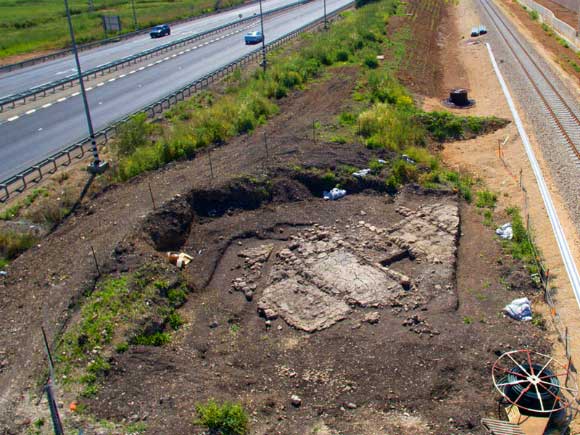Archaeologists from the Israel Antiquities Authority (IAA) have uncovered the remains of 1,600-year-old glass kilns (Late Roman period) in the Jezreel Valley, Israel.

Small fragments of raw glass as they were found at the site. Image credit: Assaf Peretz / Israel Antiquities Authority.
According to Dr. Yael Gorin-Rosen, head curator of the IAA’s Glass Department, these kilns indicate that Israel was one of the foremost centers for glass production in the ancient world.
The kilns consisted of two built compartments: a firebox where kindling was burnt to create a very high temperature, and a melting chamber – in which the raw materials for the glass (clean beach sand and salt) were inserted and melted together at a temperature of 1,200 degrees Celsius.
The glass was thus heated for a week or two until enormous chunks of raw glass were produced, some of which weighed in excess of 10 tons.
At the end of the process the kilns were cooled. The large glass chunks that were manufactured were broken into smaller pieces and were sold to workshops where they were melted again in order to produce glassware.
“This is a very important discovery with implications regarding the history of the glass industry both in Israel and in the entire ancient world,” Dr. Gorin-Rosen said.
“We know from historical sources dating to the Roman period that the Valley of Akko was renowned for the excellent quality sand located there, which was highly suitable for the manufacture of glass.”
“Chemical analyses conducted on glass vessels from this period which were discovered until now at sites in Europe and in shipwrecks in the Mediterranean basin have shown that the source of the glass is from our region.”
“Now, for the first time, the kilns have been found where the raw material was manufactured that was used to produce this glassware.”

1,600-year-old glass kilns. Image credit: Assaf Peretz / Israel Antiquities Authority.
“This is a sensational discovery and it is of great significance for understanding the entire system of the glass trade in antiquity,” added Prof. Ian Freestone, a researcher with the University College London, UK.
“This is evidence that Israel constituted a production center on an international scale; hence its glassware was widely distributed throughout the Mediterranean and Europe.”
During the Early Roman period the use of glass greatly expanded due to its characteristics: its transparency, beauty, the delicacy of the vessels and the speed with which they could be produced by blowing – an inexpensive technique adopted at the time that lowered production costs.
Glass was used in almost every household from the Roman period onward, and it was also utilized in the construction of public buildings in the form of windows, mosaics and lighting fixtures.
Consequently, large quantities of raw glass were required which were prepared on an industrial scale in specialized centers.
According to a price edict circulated by the Roman emperor Diocletian in the early 4th century CE, there were two kinds of glass: the first was known as Judean glass (from the Land of Israel) and the second – Alexandrian glass (from Alexandria, Egypt). Judean glass was a light green color and less expensive than Egyptian glass.







